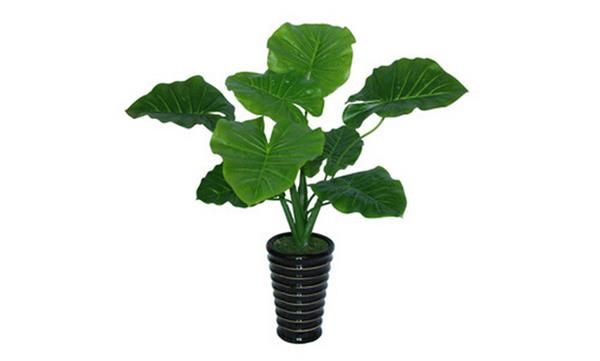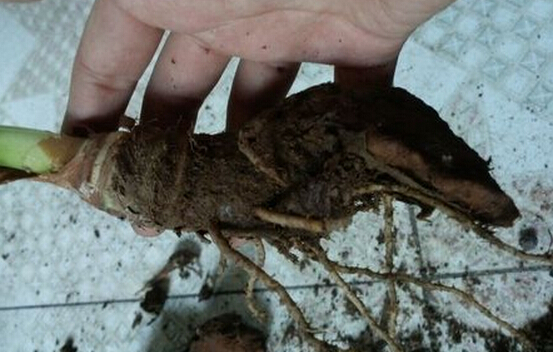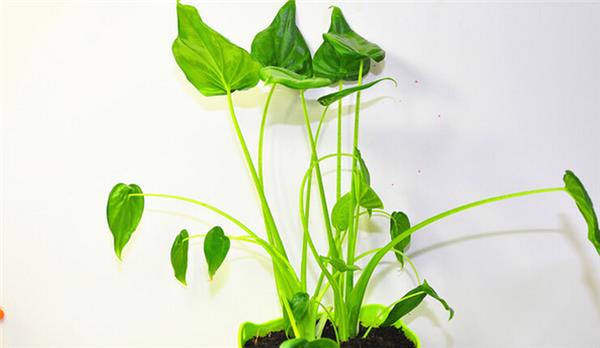Master the cultivation methods and precautions of Dishui Guanyin to create a healthy and beautiful Dishui Guanyin
Dishui Guanyin, also known as Dishui lotus, bergamot lotus, it has a beautiful connotation, the page is large but not public, implicit and low-key. Because it blossoms like Guanyin and drips down from the tip of the leaf when there is plenty of water, it has the reputation of dripping Guanyin, which is often used to decorate the interior. Although it has a good name and inner self-cultivation, we do not know much about the breeding methods and matters needing attention of Dishui Guanyin. Here, the editor will introduce you some knowledge about how to raise Dishui Guanyin.

1. Temperature: like warmth, growing rapidly when the temperature is more than 25 ℃, and the most suitable temperature for growth is 25ml / 30C. It has a certain ability to resist cold, and the overwintering temperature can be maintained above 2 ℃.
2. Light: like semi-overcast, can not bear the exposure of strong sunlight. From May to September, shade should be provided to cover about 50% of the sun. The rest of the time should be given plenty of sunshine. Do not tolerate excessive shading, otherwise the petiole becomes thinner and longer, not only the plant shape is not beautiful, but also easy to break.
3. Watering: because the leaves are huge and consume a lot of water, they are afraid of drought. Like the slightly wet soil environment, during the growth period of watering to master "dry and wet and wet", watering should be adequate, even if it is watered more. Especially in the hot summer, we should pay more attention to the supply of water to meet the water requirements of the plant. Because of the large leaf surface, water droplets often spit out at the leaf tip in the morning, which is very strange, so it is known as "dripping Guanyin". However, it is required to keep the basin soil moist at ordinary times to ensure that the plant absorbs enough water and rely on the root pressure of the plant to transport the water to the leaf tip and spit it out; when the basin soil is dry, there will be no water to drop. In winter, the moisture should be controlled to keep the basin soil slightly moist, as long as the leaves are not soft and sagging; if the basin soil is too wet, it is easy to lead to rotten roots.
4, environmental humidity: like the humid environment, avoid dry air, the growing season is sunny and dry, should often spray water to the branches and leaves and around, in order to maintain high air relative humidity.

5. Fertilization; like to be fertilized. Due to the large growth, it is necessary to supplement nutrients in time in order to make the stem grow stout, the leaves are large and bright green, and the leaves are small and yellow when lack of fertilizer. Nitrogen-based fertilizer should be applied every 10 days during the growth period. People stop applying nitrogen fertilizer after autumn and topdressing 230: phosphorus and potassium fertilizer. Stop fertilizing in winter.
6. Pruning: yellow leaves should be cut off at any time. Because the petiole is long, it is necessary to avoid breaking the petiole when moving, placing and maintaining. If it is injured, it should be cut off in time.
7. Turn the basin: turn the basin once every 1 ~ 2 years. The requirement for soil is not high, but it likes the sandy loam with fertile, loose and good drainage, and the matrix can be prepared with rotten leaf soil, garden soil, peat soil, river sand and other materials. If sufficient basal fertilizer is applied, the leaves can be enlarged. Due to the large number of leaves and small number, long petiole, moving plants and maintenance, should avoid damage to the leaves, otherwise it will reduce the ornamental value.
8. Reproduction: sowing, cutting, ramet, etc.
The main results are as follows: (1) sowing: wild plants often bear seeds and sow in spring. The suitable temperature for germination is 25-28 ℃, and germinates 20-25 days after sowing.
(2) insertion: it will be carried out in April. Cut the sturdy stem, which grows about 10 cm, and use the stem segment with several bud eyes as cuttings, slightly dry and then obliquely insert or lie flat on the seedbed, with the depth of the stem segment buried; the cuttings can also be directly planted in the basin. Keeping the substrate moist and ambient temperature 25~2TC after insertion, it can take root and survive after 4-5 weeks.
(3) ramet: the potted plant is easy to produce many small plants in the base, which can be divided in April, and the small plant and the mother plant can be separated and planted respectively. Ramet should be carried out when the temperature reaches 20C or higher, and new buds can be produced in about 20 days on the basis of keeping the substrate moist.

Dishui Guanyin, also known as Dishui lotus and bergamot, is a perennial herb. It has a beautiful connotation, the page is large but not flamboyant, implicit and low-key. Because it blossoms like Guanyin and drips down from the tip of the leaf when there is plenty of water, it has the reputation of dripping Guanyin, which is often used to decorate the interior. So, when raising Dishui Guanyin, we will always encounter all kinds of problems. What should we do?
1. What is the reason for the yellowing of Guanyin leaves?
Answer: the dripping Guanyin basin soil has been too wet or too dry for a long time, and it has not been watered immediately. Pour "half of the water", that is, the water is not watered thoroughly, and there is water seepage at the bottom of the Guanyin basin without dripping water. When it is cold in winter, the roots of dripping Guanyin have been frostbitten. The leaves of dripping Guanyin have not been cleaned with water for a long time, and dust accumulates, which hinders photosynthesis. After the winter, Dishui Guanyin was eager to get out of the room and bask in the sun in a warm place, unable to adapt to the abrupt climate. Dishui Guanyin has been placed in an environment with poor ventilation for a long time.
two。 Touch dripping Guanyin juice poisoning how to do?
A: vinegar is recommended for detoxification. Rinse with plenty of water. Toxic ingredients are calcium oxalate and saponins (Sapotoxin); itching after skin contact with juice; blindness caused by eye contact. Folk vinegar with a little ginger juice co-boiled, oral or gargle to detoxify. If the symptoms of poisoning are obvious, it is recommended to go to the hospital.
3. What about dripping Guanyin rotten roots?
Answer: Dishui Guanyin is prone to rot in summer, mainly because the soil is too wet. Pull up the dripping Guanyin, cut off the rotten roots, and wear rubber gloves when cutting the roots (Dishui Guanyin is poisonous! Be careful if you have skin allergies.) Cut off some of the healthy tissue near the rotten part. Dry, heal the wound and then plant it in plain sand or sand soil, do not water it for the time being, wait until the basin soil is dry and then water it. It will be the same in the future, no work, no watering. In addition, it should be placed in a ventilated place.

4. Why does Guanyin drip in the morning?
A: under warm and humid conditions with sufficient soil moisture, Dishui Guanyin will drip water down from the tip or edge of the leaf; if the air humidity is too low, the moisture will evaporate immediately. Because the temperature is lower at night, there is no sun exposure, and the air humidity is high, so the phenomenon of spitting water in the morning is obvious. Therefore, in general, water droplets spit more in the morning.
5. Dripping Guanyin waterborne how to grow?
Answer: hydroponic requirements: light scattering, winter can be sufficient. The water in the container should be changed frequently, and the container and the root of the plant should be cleaned when changing the water. It is best to rinse with tap water and disinfect it with potassium permanganate solution if possible. It is best to keep the temperature above 12 ℃. Because it is hydroponic, the air humidity can generally meet the demand. When hydroponic culture, don't get into the water too much, just enter the water with half of the lower root system.
6. What's the problem when Dishui Guanyin falls down?
Answer: as the usual watering is only on the roots, the water can not supply the leaves, so it will pour. It is recommended that the clear water be installed in the spray can and sprayed on the leaves. In a few days, it will be effective.
7. How does Dishui Guanyin take care of?
Answer: its transpiration will be reduced in winter. if it is a newly transplanted seedling, you can keep the surrounding environment moist after the original soil is moist, and spray the surrounding environment with a water-spraying pot; if Lao Miao, touch the soil on the surface with your hands and water only when it is dry, but not too much, because the temperature is below 18 degrees Celsius, dripping Guanyin hibernates, does not grow much, and does not need much water, otherwise it will rot the roots.
8. What if Dishui Guanyin is too high?
A: by spraying 2% paclobutrazol solution throughout the plant, during the later growth process of dripping Guanyin, it will be found that the growth height of dripping Guanyin is not higher than 40cm. If dripping Guanyin continues to grow, you can spray the whole plant again. Generally, the effect of controlling height can be achieved by spraying once in half a year.

Dishui Guanyin is also a resident family member in the editor's home. It has an elegant and beautiful appearance, slender branches, large and green leaves, and drips of water from time to time in summer, which is deeply loved by the editor. So, what is the fengshui effect of Dishui Guanyin?
As the leaves of Dishui Guanyin are very large, so it is very eye-catching in the bedroom, and it is a very good choice to use it to adjust the color and set off the home atmosphere. This kind of ornamental plant is often used as the background of household "picture", so we don't have to think about it to know how suitable it is to set off the atmospheric home background of Dishui Guanyin, a plant with a strong sense of existence. so the Chinese style is also more suitable for Dishui Guanyin.
The breeding methods and matters needing attention of Dishui Guanyin are introduced here. I hope you can understand the relevant habits of how to raise Dishui Guanyin, as well as the knowledge that its juice and roots are toxic. It can be viewed from a distance and can not be played with, so as to carry forward its ornamental value.
If the symptoms of poisoning are obvious, it is recommended to go to the hospital.
3. What about dripping Guanyin rotten roots?
Answer: Dishui Guanyin is prone to rot in summer, mainly because the soil is too wet. Pull up the dripping Guanyin, cut off the rotten roots, and wear rubber gloves when cutting the roots (Dishui Guanyin is poisonous! Be careful if you have skin allergies.) Cut off some of the healthy tissue near the rotten part. Dry, heal the wound and then plant it in plain sand or sand soil, do not water it for the time being, wait until the basin soil is dry and then water it. It will be the same in the future, no work, no watering. In addition, it should be placed in a ventilated place.

4. Why does Guanyin drip in the morning?
A: under warm and humid conditions with sufficient soil moisture, Dishui Guanyin will drip water down from the tip or edge of the leaf; if the air humidity is too low, the moisture will evaporate immediately. Because the temperature is lower at night, there is no sun exposure, and the air humidity is high, so the phenomenon of spitting water in the morning is obvious. Therefore, in general, water droplets spit more in the morning.
5. Dripping Guanyin waterborne how to grow?
Answer: hydroponic requirements: light scattering, winter can be sufficient. The water in the container should be changed frequently, and the container and the root of the plant should be cleaned when changing the water. It is best to rinse with tap water and disinfect it with potassium permanganate solution if possible. It is best to keep the temperature above 12 ℃. Because it is hydroponic, the air humidity can generally meet the demand. When hydroponic culture, don't get into the water too much, just enter the water with half of the lower root system.
6. What's the problem when Dishui Guanyin falls down?
Answer: as the usual watering is only on the roots, the water can not supply the leaves, so it will pour. It is recommended that the clear water be installed in the spray can and sprayed on the leaves. In a few days, it will be effective.
7. How does Dishui Guanyin take care of?
Answer: its transpiration will be reduced in winter. if it is a newly transplanted seedling, you can keep the surrounding environment moist after the original soil is moist, and spray the surrounding environment with a water-spraying pot; if Lao Miao, touch the soil on the surface with your hands and water only when it is dry, but not too much, because the temperature is below 18 degrees Celsius, dripping Guanyin hibernates, does not grow much, and does not need much water, otherwise it will rot the roots.
8. What if Dishui Guanyin is too high?
A: by spraying 2% paclobutrazol solution throughout the plant, during the later growth process of dripping Guanyin, it will be found that the growth height of dripping Guanyin is not higher than 40cm. If dripping Guanyin continues to grow, you can spray the whole plant again. Generally, the effect of controlling height can be achieved by spraying once in half a year.

Dishui Guanyin is also a resident family member in the editor's home. It has an elegant and beautiful appearance, slender branches, large and green leaves, and drips of water from time to time in summer, which is deeply loved by the editor. So, what is the fengshui effect of Dishui Guanyin?
As the leaves of Dishui Guanyin are very large, so it is very eye-catching in the bedroom, and it is a very good choice to use it to adjust the color and set off the home atmosphere. This kind of ornamental plant is often used as the background of household "picture", so we don't have to think about it to know how suitable it is to set off the atmospheric home background of Dishui Guanyin, a plant with a strong sense of existence. so the Chinese style is also more suitable for Dishui Guanyin.
The breeding methods and matters needing attention of Dishui Guanyin are introduced here. I hope you can understand the relevant habits of how to raise Dishui Guanyin, as well as the knowledge that its juice and roots are toxic. It can be viewed from a distance and can not be played with, so as to carry forward its ornamental value.
Related
- Wuhan Hospital Iron Tree Blooming Result Was Instantly Frightened by the Gardener Master
- Which variety of camellia is the most fragrant and best? Which one do you like best?
- What is the small blue coat, the breeding methods and matters needing attention of the succulent plant
- Dormancy time and maintenance management of succulent plants during dormancy
- Minas succulent how to raise, Minas succulent plant pictures
- What are the varieties of winter succulent plants
- How to raise succulent plants in twelve rolls? let's take a look at some experience of breeding twelve rolls.
- Attention should be paid to water control for succulent plants during dormant period (winter and summer)
- Watering experience of twelve rolls of succulent plants
- Techniques for fertilizing succulent plants. An article will let you know how to fertilize succulent plants.



